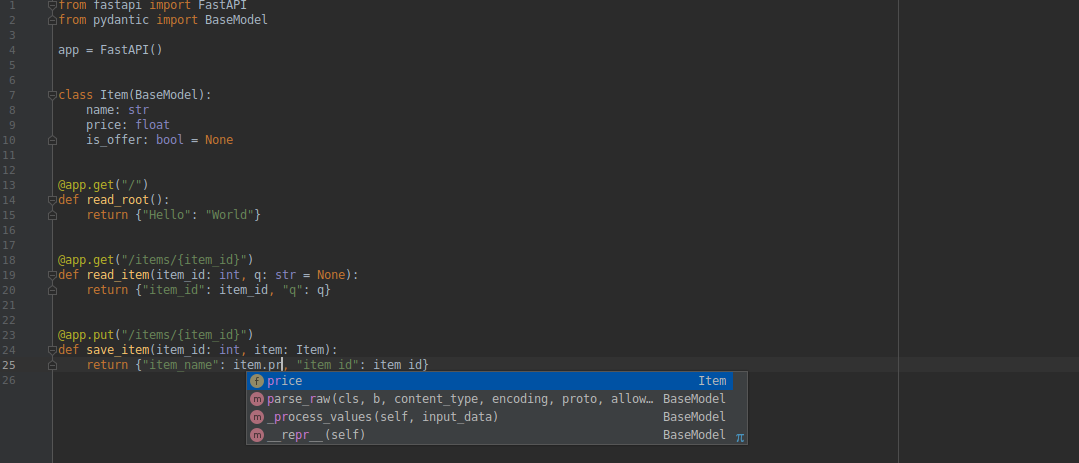- Sort Score
- Result 10 results
- Languages All
Results 1 - 10 of 124 for requis (0.16 sec)
-
docs/fr/docs/tutorial/query-params-str-validations.md
{!../../../docs_src/query_params_str_validations/tutorial005.py!} ``` !!! note "Rappel" Avoir une valeur par défaut rend le paramètre optionnel. ## Rendre ce paramètre requis Quand on ne déclare ni validation, ni métadonnée, on peut rendre le paramètre `q` requis en ne lui déclarant juste aucune valeur par défaut : ```Python q: str ``` à la place de : ```Python q: Union[str, None] = None ```Plain Text - Registered: Sun May 05 07:19:11 GMT 2024 - Last Modified: Thu Jul 27 18:53:21 GMT 2023 - 9.8K bytes - Viewed (0) -
docs/fr/docs/python-types.md
* **de la vérification de types** ...et **FastAPI** utilise ces mêmes déclarations pour : * **Définir les prérequis** : depuis les paramètres de chemins des requêtes, les entêtes, les corps, les dépendances, etc. * **Convertir des données** : depuis la requête vers les types requis. * **Valider des données** : venant de chaque requête : * Générant automatiquement des **erreurs** renvoyées au client quand la donnée est invalide.Plain Text - Registered: Sun May 05 07:19:11 GMT 2024 - Last Modified: Fri Mar 22 01:42:11 GMT 2024 - 10.3K bytes - Viewed (0) -
fastapi/security/oauth2.py
) self.scheme_name = scheme_name or self.__class__.__name__ self.auto_error = auto_error async def __call__(self, request: Request) -> Optional[str]: authorization = request.headers.get("Authorization") if not authorization: if self.auto_error: raise HTTPException(Python - Registered: Sun May 05 07:19:11 GMT 2024 - Last Modified: Tue Apr 02 02:48:51 GMT 2024 - 21.1K bytes - Viewed (1) -
docs/en/docs/alternatives.md
It is designed to have functions that receive two parameters, one "request" and one "response". Then you "read" parts from the request, and "write" parts to the response. Because of this design, it is not possible to declare request parameters and bodies with standard Python type hints as function parameters.
Plain Text - Registered: Sun May 05 07:19:11 GMT 2024 - Last Modified: Thu Apr 18 19:53:19 GMT 2024 - 23.2K bytes - Viewed (0) -
docs/en/docs/advanced/generate-clients.md
``` === "Python 3.8+" ```Python hl_lines="9-11 14-15 18 19 23" {!> ../../../docs_src/generate_clients/tutorial001.py!} ``` Notice that the *path operations* define the models they use for request payload and response payload, using the models `Item` and `ResponseMessage`. ### API Docs If you go to the API docs, you will see that it has the **schemas** for the data to be sent in requests and received in responses:Plain Text - Registered: Sun May 05 07:19:11 GMT 2024 - Last Modified: Thu Apr 18 19:53:19 GMT 2024 - 10.5K bytes - Viewed (0) -
fastapi/security/http.py
self.scheme_name = scheme_name or self.__class__.__name__ self.auto_error = auto_error async def __call__( self, request: Request ) -> Optional[HTTPAuthorizationCredentials]: authorization = request.headers.get("Authorization") scheme, credentials = get_authorization_scheme_param(authorization) if not (authorization and scheme and credentials):Python - Registered: Sun May 05 07:19:11 GMT 2024 - Last Modified: Fri Apr 19 15:29:38 GMT 2024 - 13.2K bytes - Viewed (0) -
docs/de/docs/deployment/https.md
### HTTPS-Request Da Client und Server (sprich, der Browser und der TLS-Terminierungsproxy) nun über eine **verschlüsselte TCP-Verbindung** verfügen, können sie die **HTTP-Kommunikation** starten. Der Client sendet also einen **HTTPS-Request**. Das ist einfach ein HTTP-Request über eine verschlüsselte TLS-Verbindung. <img src="/img/deployment/https/https04.svg">
Plain Text - Registered: Sun May 05 07:19:11 GMT 2024 - Last Modified: Sat Mar 30 20:16:46 GMT 2024 - 13.5K bytes - Viewed (0) -
docs/en/docs/contributing.md
Plain Text - Registered: Sun May 05 07:19:11 GMT 2024 - Last Modified: Thu Jan 11 17:42:43 GMT 2024 - 14.1K bytes - Viewed (0) -
docs/vi/docs/features.md
 Bạn sẽ có được auto-completion trong code, thậm chí trước đó là không thể. Như trong ví dụ, khóa `price` bên trong một JSON (đó có thể được lồng nhau) đến từ một request. Không còn nhập sai tên khóa, quay đi quay lại giữa các tài liệu hoặc cuộn lên cuộn xuống để tìm xem cuối cùng bạn đã sử dụng `username` hay `user_name`. ### Ngắn gọn
Plain Text - Registered: Sun May 05 07:19:11 GMT 2024 - Last Modified: Thu Apr 18 19:53:19 GMT 2024 - 11.6K bytes - Viewed (0) -
docs/en/docs/advanced/behind-a-proxy.md
```Python hl_lines="6" {!../../../docs_src/behind_a_proxy/tutorial001.py!} ``` And the proxy would be **"stripping"** the **path prefix** on the fly before transmitting the request to the app server (probably Uvicorn via FastAPI CLI), keeping your application convinced that it is being served at `/app`, so that you don't have to update all your code to include the prefix `/api/v1`.Plain Text - Registered: Sun May 05 07:19:11 GMT 2024 - Last Modified: Thu May 02 22:37:31 GMT 2024 - 11.6K bytes - Viewed (2)